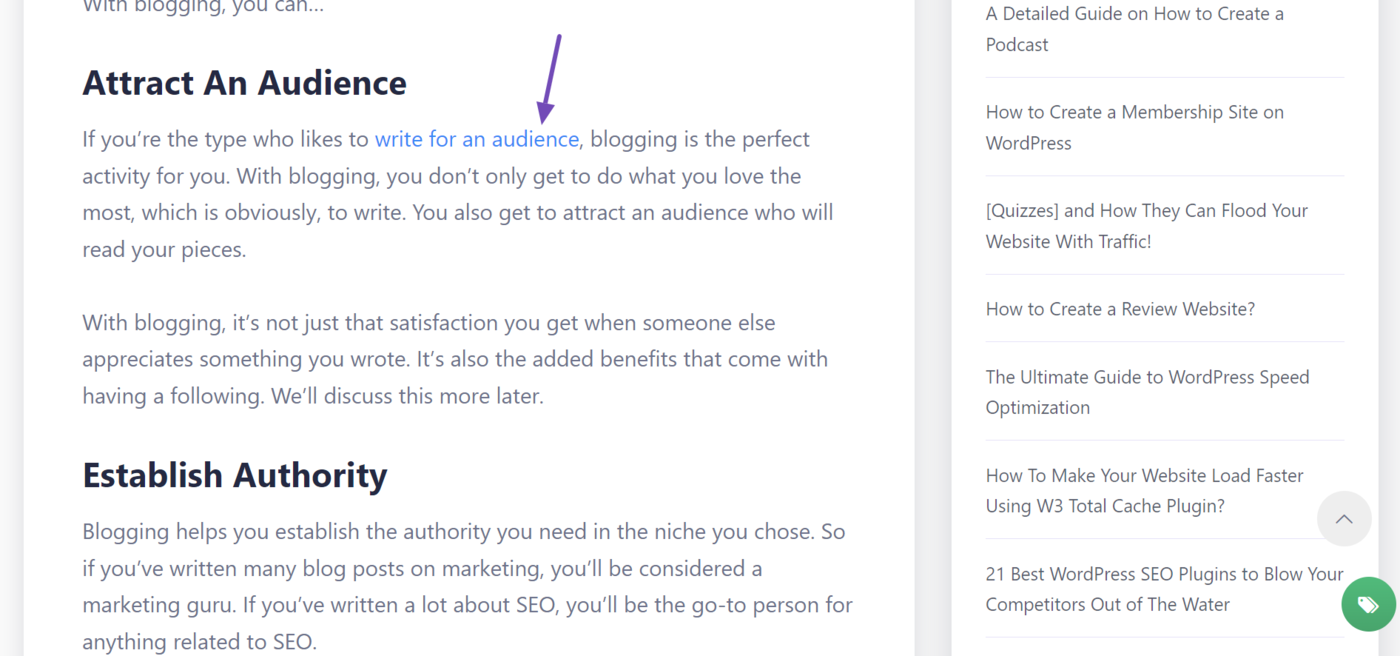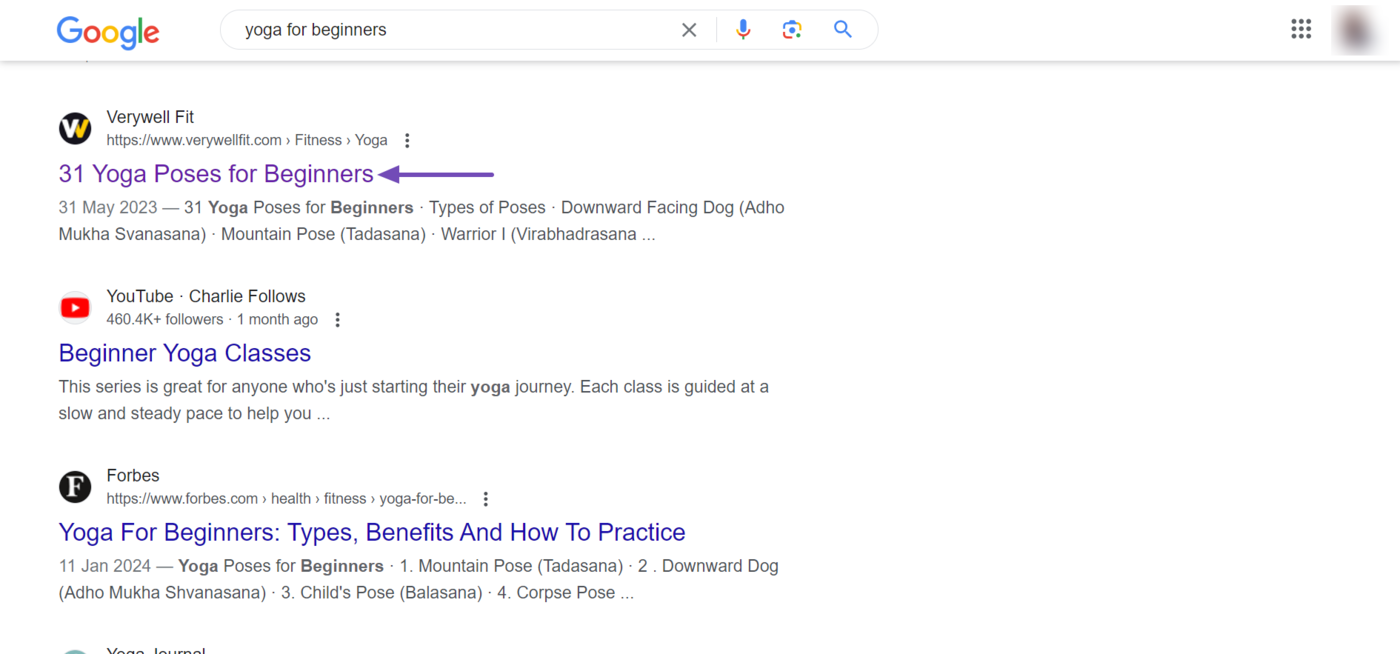What is an Anchor Text?
An anchor text is the clickable text in a hyperlink. When clicked, it directs the visitor to a section of the current page or another page. This page could be on the same site or a different site.
Anchor texts are often styled differently from the other text on the webpage. In most instances, the anchor text is blue and may be underlined.

When clicked, the text may turn purple.

When you check your source code, your anchor text will appear as shown below:
<a href="https://yourdomain.com/best-yoga-poses/">What are the best yoga poses?</a>
In the above code:
What are the best yoga poses?is the anchor text. This is what the visitor sees on their screenhttps://yourdomain.com/best-yoga-poses/is the target URL visitors are directed to when they click the anchor text. Visitors do not see this
Google uses anchor text as one of the signals to understand the content of the page it links to. Besides the SEO benefits, the anchor text allows visitors to understand the content they are being redirected to.
Types of Anchor Texts
Anchor texts are typically categorized based on the words and keywords they contain and their relationship with the target keyword and URL. The types of anchor texts include:
- Exact match
- Phrase match
- Partial match
- Branded
- Generic
- Naked URL
- Image alt Text
Let us explain these anchor texts one by one, along with relevant examples.
1 Exact Match
An exact match anchor text contains the keyword for which the page is looking to rank.
For example, the anchor text Vanilla Cake Recipe leads to a webpage trying to rank for the keyword “Vanilla Cake Recipe.”
2 Phrase Match
A phrase match anchor text contains a phrase that closely matches a phrase or set of keywords for which the page is looking to rank.
For example, the anchor text best restaurant in New York City leads to a webpage trying to rank for the keyword “Top restaurants in New York City.”
3 Partial Match
A particle match anchor text contains several words, including the keyword for which the page being linked is trying to rank.
For example, the anchor text best yoga poses for beginners leads to a webpage trying to rank for the keyword “yoga poses.”
4 Branded
A branded anchor text contains the name of the site hosting the webpage that is being linked to.
For example, the anchor text Wikipedia leads to a Wikipedia article on airplanes.
5 Generic
A generic anchor text contains text that does not inform visitors of the content on the page that is being linked to.
Typically, the text instructs the visitor to perform an action. For example, read more, learn more, and click here.
6 Naked URL
A naked URL contains the URL of the page you are being linked to. For example, https://yourdomain.com/birthday-cake-recipe.
7 Image Alt Text
The alt text is a brief description of the image on a webpage. When you embed a link in an image, Google will consider the alt text as the link’s anchor text.
Anchor Text Best Practices
Anchor texts provide the pages they link to with some SEO benefits. They can also affect the user experience of visitors to the page. Here are a few best practices you should follow to get the most out of your anchor texts.
1 Use Descriptive Anchor Texts
Ensure your anchor text describes the page it leads to. Your visitors should know the type of content at the target URL from just reading the anchor text.
Exact, phrase, and partial match are the most descriptive anchor texts. For this reason, they are often used on sites looking to rank on search engines.
2 Use Different Anchor Texts
Use different anchor texts when linking to the same page.
While you have little to no control over anchor texts on external sites, this is typically not an issue since bloggers will naturally use different anchor texts when linking to you.
However, you should ensure to use different anchor texts when using internal links or when linking from a partner site.
Using the same anchor text looks spammy and unnatural. Google may even consider it keyword stuffing, which may attract some penalties.
3 Use Intelligible Anchor Texts
Don’t stuff keywords into your anchor text.
Keyword stuffing is a spamming tactic in which you forcefully include the keywords you are trying to rank for in a piece of content or link, even when the keyword sounds out of place or makes the content unintelligible.
Keyword stuffing makes your anchor text look unnatural and spammy. It is also a black hat SEO technique and may earn you a penalty from Google. Instead, use anchor texts that are descriptive and intelligible to a human.
4 Use Relevant Anchor Texts
Your anchor texts must be relevant to the page that they link to. For example, an anchor text like vanilla cake recipe should lead to a page about vanilla cake recipes.
If the anchor text leads to a totally unrelated page, say a page about construction or furniture repair, it will result in a negative user experience for the visitor and may even be considered spam.
5 Use Short Anchor Texts
Limit the length of your anchor text to a few words. Keep your anchor texts short and concise.
Excessively long anchor texts look unnatural and will be different from what the visitor expects to see.
6 Use Distinctive Anchor Texts
Format your anchor texts differently from other content on the page.
Anchor texts should be easily identifiable from the other content on the site. It is best practice to style your anchor text differently from the rest of the textual content on the page.
Most sites typically style their anchor texts in a blue color. Some may also underline their anchor texts.